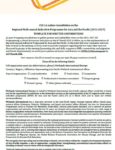At the beginning of March, the Directorate General for International Partnerships organised a virtual discussion to follow up on the implementation of the Multi-annual Indicative Programme for Asia and the Pacific. Wetlands International Europe participated in the meeting and contributed with written recommendations to questions related to climate change, energy and environment.
Wetlands International has a long-term presence in the Asia-Pacific region, through regional offices (South Asia), national offices (Indonesia, Malaysia, Philippines, and Japan) and project offices (Brunei), but also via international programmes (such as Partners for Resilience, Watershed), its national government members, and a network of partner organisations and networks. During the last 25 years, our projects and partnerships have focused on a wide range of themes ranging from wetlands restoration, river basin and coastal zone scale integrated management planning, wetland ecosystem services mainstreaming in developmental planning to communication, education and capacity development for wetland conservation and wise use.
We recognise that upscaling and accelerating wetland conservation within the complex development dynamics of the Asia-Pacific requires a mix of approaches, ranging from strengthening conventional conservation efforts to blending wetlands conservation with development outcomes.
Changes and degradation of wetlands particularly in their structure and functions can lead to significant changes in their flow pattern and the chemical and microbiological character of water resources. At the same time, wetlands require sufficient water to maintain an optimal level of ecological health. Given the fact that most of the impacts of climate change in the region would be water-mediated, integrating the role of wetlands in climate change solutions demands urgent attention and integration in mitigation and adaptation strategies.
With regards to the development of the water-energy nexus, we identify as key priorities the following:
- Accelerating adaptation by integrating nature-based solutions into water-related infrastructure in Asia to build climate resilient landscapes that benefit people and nature, through the initiative Building with Nature Asia (see examples of our work below). Building with Nature solutions can accelerate adaptation, enhance water and food supply, livelihoods, carbon storage, biodiversity conservation and health. It represents a paradigm shift from minimising negative impacts to maximising positive benefits for society and nature. As a result, there is growing recognition for Building with Nature as a leading climate change adaptation strategy.
- Restoring and reconnecting wetland systems across all landscapes is the basis for solving the challenges of water, food, climate, land degradation, human security and sustainable economies.
- Investing in Blue-Green and Grey-Green Infrastructure which interconnect networks of natural and semi-natural areas and are vital for building city and landscape resilience in the face of climate threats. As a part of an integrated master plan, nature restoration and Blue-Green and Grey-Green Infrastructure can be combined with traditional engineering measures. If we merge the dynamic and adaptable properties of natural areas (wetlands) with the seminatural (linear parks with roads), that are interconnected (with drainage systems and green roof corridors), we end up with Blue-Green and Grey-Green Infrastructure. This interconnected networks allows the flow of persons, water and biodiversity. Additionally, the disaster risks related to climate change, such as floods, droughts and landslides could be reduced. At the global level, there is increasing interest in well-managed Blue-Green and Grey-Green Infrastructure which is economical, scalable and sustainable. It could even contribute to the grey infrastructure. For example, preserving highland wetlands can contribute to the supply of water to a hydropower dam downstream.
- Pushing for collaborative governance solutions is crucial for addressing challenges associated with building coherent conceptual and methodological narratives (such as wetlands degradation not just seen as tantamount to loss of critical ecosystem services, but reduced landscape resiliency to increasing water risks), and developing approaches for joint working that have potential to transform, rather than simply reaffirm segmented ways of research on natural systems and landscapes.
The full set of recommedations can be found here: 03.15-Written-Input-RMIP-Asia-Pacific_Wetlands-International.pdf

